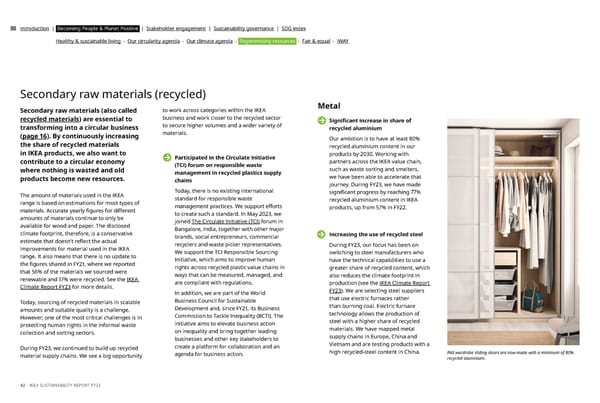Introduction | Becoming People & Planet Positive | Stakeholder engagement | Sustainability governance | SDG index Healthy & sustainable living - Our circularity agenda - Our climate agenda - Regenerating resources - Fair & equal - IWAY Secondary raw materials (recycled) Secondary raw materials (also called to work across categories within the IKEA Metal recycled materials) are essential to business and work closer to the recycled sector to secure higher volumes and a wider variety of Signi昀椀cant increase in share of transforming into a circular business materials. recycled aluminium (page 16). By continuously increasing Our ambition is to have at least 80% the share of recycled materials recycled aluminium content in our in IKEA products, we also want to Participated in the Circulate Initiative products by 2030. Working with contribute to a circular economy (TCI) forum on responsible waste partners across the IKEA value chain, where nothing is wasted and old management in recycled plastics supply such as waste sorting and smelters, products become new resources. chains we have been able to accelerate that journey. During FY23, we have made Today, there is no existing international The amount of materials used in the IKEA signi昀椀cant progress by reaching 77% range is based on estimations for most types of standard for responsible waste recycled aluminium content in IKEA management practices. We support e昀昀orts products, up from 57% in FY22. materials. Accurate yearly 昀椀gures for di昀昀erent to create such a standard. In May 2023, we amounts of materials continue to only be joined The Circulate Initiative (TCI) forum in available for wood and paper. The disclosed Bangalore, India, together with other major climate footprint, therefore, is a conservative brands, social entrepreneurs, commercial Increasing the use of recycled steel estimate that doesn't re昀氀ect the actual recyclers and waste picker representatives. During FY23, our focus has been on improvements for material used in the IKEA We support the TCI Responsible Sourcing switching to steel manufacturers who range. It also means that there is no update to Initiative, which aims to improve human have the technical capabilities to use a the 昀椀gures shared in FY21, where we reported rights across recycled plastic value chains in greater share of recycled content, which that 56% of the materials we sourced were ways that can be measured, managed, and also reduces the climate footprint in renewable and 17% were recycled. See the IKEA are compliant with regulations. production (see the IKEA Climate Report Climate Report FY23 for more details. FY23). We are selecting steel suppliers In addition, we are part of the World that use electric furnaces rather Today, sourcing of recycled materials in scalable Business Council for Sustainable than burning coal. Electric furnace amounts and suitable quality is a challenge. Development and, since FY21, its Business technology allows the production of However, one of the most critical challenges is in Commission to Tackle Inequality (BCTI). The steel with a higher share of recycled protecting human rights in the informal waste initiative aims to elevate business action materials. We have mapped metal collection and sorting sectors. on inequality and bring together leading supply chains in Europe, China and businesses and other key stakeholders to Vietnam and are testing products with a During FY23, we continued to build up recycled create a platform for collaboration and an high recycled-steel content in China. material supply chains. We see a big opportunity agenda for business action. PAX wardrobe sliding doors are now made with a minimum of 80% recycled aluminium. 42 - IKEA SUSTAINABILITY REPORT FY23
 IKEA ESG FY23 Report Page 41 Page 43
IKEA ESG FY23 Report Page 41 Page 43